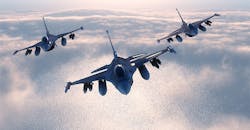To say that data is an important part of modern life may be a bit of an understatement. In an ever-more digital world, data is everywhere. During the past two years, more data was created than during the history of the planet leading to that two-year period. And by as soon as 2020, approximately 1.7 MB of new information (data) will be created per second for every living person on the planet.
On its own, data is largely meaningless. It can be considered digital noise, a series of 1’s and 0’s. Value comes from specific, targeted, and critical data that can be placed in the hands of those who need it the most at precisely the right moment, allowing them to extract and use the data for meaningful results. All of this raises a larger issue of security, particularly in terms of military- and defense-based environments.
Civilians are certainly aware of some of the dangers they face in terms of data security, with consequences such as fraud and identity theft looming should their personal data fall into the wrong hands. Even greater dangers await for cases of insufficient data security on the battlefield. Lives are at stake when data is being transmitted from an aircraft traveling in excess of 1000 mph to command crews on the ground. For something as essential as national security, nothing can be left to chance in terms of the reliability and security of critical data. These are the types of concerns that Tactical Targeting Network Technology (TTNT) were designed to address.
What Exactly is TTNT?
TTNT is a very specific type of waveform technology intended to meet a pressing need for high-throughput, anti-jam, low-latency, and quick-network-join waveforms for Internet Protocol (IP) connectivity as it relates to the Global Information Grid. Essentially, it's a way to deliver the fastest and most secure ad hoc mesh network for instantly and accurately sharing voice, video, and data between two points, especially for fast-moving users. The architecture of the technology is based largely on the Joint Airborne Network-Tactical Edge (JAN-TE) capabilities document, which itself was based on the Time Sensitive Target Networking Technology requirements of the Tactical Data Link Transformation Capability Document.
This type of technology offers a wide range of benefits, particularly in terms of defense and government applications. Not only does it provide a low-latency, ad hoc, IP-based network functionality, but it can successfully do so for more than 200 users at any given time. The connection itself is also “self-forming” and “self-healing.” That means communicating platforms/users can automatically join and leave the network without any type of advanced planning, which can be a hurdle for the use of other types of networking options. Such network access is very beneficial for situations where multiple aircraft might be in communication with each other, as well as with crews on the ground.
TTNT is designed for secure, high-speed communications by users moving at high speeds. It enables instant and secure sharing of voice, video, and data between radios at relative speeds to Mach 8, or about 6138 mph. This capability is beneficial when two high-speed aircraft must be in secure communications with each other, even when they are moving in different directions. Beyond the speed of the users, the volume of data for TTNT is significant, with a specification of 10 Mb/s at a distance of 300 nautical miles.
TTNT has been developed to protect data in a number of ways, including increasing the chances that the data will be seen by means of prioritization. Using an advanced statistical priority-based multiple-access (SPMA) protocol, TTNT sends critical data first; lower-priority data is not transmitted in a communication until absolutely needed.
1. TTNT is a secure, high-speed networking communications technology that’s designed for point-to-point links on the move, such as fighter aircraft and ground networking nodes.
Additional benefits of TTNT include a strong “anti-jam” feature that’s particularly useful in a contested environment. The technology employs a multiple-hop relay and automatic routing techniques to extend the reach of a secure communications system beyond line of sight, along with the fact that the platform itself allows for the simultaneous transmission and reception of as many as four different data streams at one time.
These capabilities of TTNT make it an essential part of modern defense and military landscapes, in no small part because of the way it satisfies the U.S. Department of Defense’s (DoD) Airborne Networking requirements. Those requirements outline a strong need for how the three segments of the DoD’s Global Information Grid—space, airborne, and terrestrial users—communicate with one another via IP-enabled network nodes. Due to almost a full decade of U. S. government investment and demonstrated applications in nearly every airborne platform in the U.S. Air Force and Navy, TTNT has already proven to be a viable, mature means of providing secure, high-speed communications between rapidly moving radio systems.
Applications for TTNT
Although TTNT has been designed for a particular group of (government and defense) users, the communications technology actually has a wide range of possible applications because of the viability and flexibility of the basic concept. For example, in 2005, the U.S. Defense Advanced Research Projects Agency (DARPA) successfully demonstrated the core technology by connecting tactical aircraft and ground communications nodes under a wide range of circumstances. These featured support for various applications that included, but are not limited to:
- Standard internet-based communications techniques such as e-mail, Internet chat, and internet access for aircraft that were already in the air.
- Voice over Internet protocol (VoIP), which transmits voice information over a data connection as an alternative to traditional telephone service.
- Support for the transmission of still images from both an aircraft to users on the ground, as well as from users on the ground to an in-flight aircraft.
- Support for the transmission of streaming, full-motion video from airborne aircraft to users on the ground.
- Enabling sophisticated aircraft procedures, such as implemented by the Joint Precision Approach and Landing System (JPALS) and the Automated Aerial Refueling System (AARS).
By design, TTNT has allowed tactical aircraft to quickly acquire time-sensitive assets that were in motion at high speeds, enabling network-centric sensor technologies to correlate information among multiple platforms, significantly increasing the accuracy in locating targets of interest (Fig. 1). In terms of military-based applications from TTNT, an example would be a squadron of fighter jets under attack by a large force and in need of secure communications.
Using TTNT and secure voice, video, and data, a ground commander could not only instantly identify support aircraft, but also correlate other critical information for the attack, including the amount and availability of fuel and ammunition (Fig. 2). It would all be accurate, actionable, and real-time information that a ground commander could use to make the best possible decisions in response to the attack.
2. The use of secure TTNT enables mobile fighting forces to make the best use of large amounts of information quickly, as might be needed when coordinating air- and ground-based forces.
In the sky, a similar example would take place in the cockpit of a fighter jet. A pilot could use information from his/her own aircraft as well as information shared via TTNT from the ground to see an enemy fighter jet aircraft approaching from the rear faster than a radar warning receiver (RWR) could identify on its own. Of course, TTNT is more than a means of sharing data in the fastest and most secure way possible. It’s also about making sure that the data gets to those who can make the best use of it, and who can keep people in potentially dangerous environments as safe and secure as possible.
Overcoming the Hurdles
Of course, TTNT is not without its challenges. Developments in new technologies will be needed to make TTNT a practical and realizable technology. Broadband hardware components for systems using TTNT include power amplifiers, antennas, and transceivers compatible with existing Joint Tactical Radio System (JTRS) hardware. While TTNT is compatible with some existing hardware (since it’s largely a new networking protocol), widespread implementation would require vast amounts of new hardware.
The TTNT network process as it relates to hardware begins with a particular user or radio system entering the range of the network. At that point, it receives a welcome signal and transmits verification information to the nearest hardware node on the ground. Subsequently, the user entering the TTNT network is connected to the nearest node and to other nodes in the area for transmission and reception of information. Upon leaving the range of the network, the user is automatically disconnected and the relevant IP address is deleted from the IP table.
For a secure communications network system to support TTNT, its hardware must be compatible. Any component that’s not compatible with TTNT must be replaced or updated. The DoD has been working on this compatibility effort since 2006, when a document was issued that mandated the integration of TTNT into MIDS-JTRS designs.
Equally as important as the technology needed for current-day TTNT will be the technology needed to help it evolve. Without that support, TTNT could go the way of Link 16 technology. Link 16 data links are still in use to transmit trend-sensing data between tactical aircraft, but they lack support for certain DARPA technologies, such as Advanced Tactical Targeting Technology (AT3). TTNT was developed in part to replace Link 16, but it must be fully supported to make that possible.
Mark Stanley is Product Manager at Epec Engineered Technologies.



